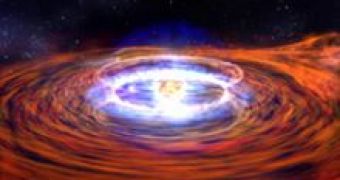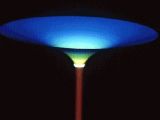The annual meeting of the American Astronomical Society in Washington, D.C. this year covered more than 30 subjects from the Sun, White Dwarfs, Pulsars and Black Holes to the evolution of Galaxies, the interstellar medium and gamma-ray bursts. Here's a short review of 5 new discoveries about black holes:
The stars orbiting close to Milky Way's black hole The origin of young stars at the center of our galaxy has puzzled astronomers, but the orbits may be the key to unlocking the mystery. The astronomers use a new laser virtual star at the W.M. Keck observatory in Hawaii. The hostile environment around the supermassive black hole should make it extremely difficult for stars to form, but many young stars have been detected around the black hole", said UCLA astronomy graduate student Jessica Lu, who reported that she and her team are tracking a puzzling group of more than 30 massive young stars of uncertain origins. "How were these stars formed in such an inhospitable region?" Lu asked. "My advisor, Andrea Ghez, calls this mystery 'the paradox of youth.' Using the Keck's Laser Guide Star adaptive optics system, we expect to resolve the paradox. We are able to measure how these young stars move across the sky with an unparalleled precision (only two kilometers per second) and determine, for the first time, the orbit of each of the young stars located a few light months from the black hole. Just as a fingerprint can be used to identify a person, the information encoded in the orbits of the young stars will tell us how and where they formed," said Lu, a member of a UCLA research team including her advisor, Ghez, a UCLA professor of physics and astronomy.
The 'eating habits' of black holes at the center of young galaxies An analysis of the Hubble Space Telescope's deepest view of the universe offers compelling evidence that monster black holes in the centers of galaxies were not born big but grew over time through repeated galactic mergers. "By studying distant galaxies in the Hubble Ultra Deep Field (HUDF), we have the first statistical evidence that supermassive black-hole growth is linked to the process of galaxy assembly," said Arizona State University astronomer Rogier Windhorst, who is a member of the two teams that conducted the analysis. "Black holes grow by drawing in stars, gas and dust. These morsels come more plentifully within their reach when galaxies merge." A link between the growth of galaxies through mergers and the feeding of the central black holes has long been suspected. The evidence, however, has been inconclusive for many years. "The HUDF has provided very high-quality information," said Seth Cohen of Arizona State University. "It is the first data we could use to test this theory, since it allowed us to study about 5,000 distant galaxies over a period of four months."
NASA'S Chandra finds black holes stirring up galaxies Black holes are creating havoc in unsuspected places, according to a new study of images of elliptical galaxies made by NASA's Chandra X-ray Observatory. The discovery of far-reaching explosive activity, due to giant central black holes in these old galaxies, was a surprise to astronomers. The Chandra data revealed an unsuspected turmoil in elliptical galaxies that belies their calm appearance in optical light. Astronomers believe massive clouds of hot gas in these galaxies have been stirred up by intermittent explosive activity from centrally located super-massive black holes. "This is another example of how valuable it is to observe the universe at different wavelengths besides just the traditional optical wavelengths," said NASA's Chandra Program Scientist Wilt Sanders. "Without these X-ray and radio observations, we wouldn't know these apparently static galaxies in reality are still evolving due to the interaction with their central black holes." These results came from an analysis of 56 elliptical galaxies in the Chandra data archive by associate professor Thomas Statler and doctoral candidate Steven Diehl, both of the Physics and Astronomy department at the Ohio University, Athens, Ohio. "Most elliptical galaxies have traditionally been considered to be quiet places, like placid lakes," Statler said. "Our results show these galaxies are a lot stormier than we thought. These results are part of an emerging picture that shows the impact of super-massive black holes on their environment is far more pervasive than previously thought."
Spinning black hole leaves dent in space-time MIT scientists have found a black hole that has chiseled a remarkably stable indentation in the fabric of space and time, like a dimple in one's favorite spot on the sofa. Black hole regions are notoriously chaotic, generating light at a range of frequencies. Similarities seen nine years apart imply something very fundamental is producing a pair of observed frequencies, namely the warping of space and time predicted by Einstein but rarely seen in such detail. "The fact that we found the exact same frequency of X-ray oscillations nine years later is likely no coincidence," said Jeroen Homan of the Kavli Institute for Astrophysics and Space Research at MIT. "The black hole is still singing the same tune. The oscillations are created by a groove hammered into space-time by the black hole. This phenomenon has been suspected for a while, but now we have strong evidence to support it."
Our galaxy's black hole emits flares In the most comprehensive study of Sagittarius A* (Sgr A*), the enigmatic supermassive black hole in the center of the Milky Way Galaxy, astronomers -- using nine ground and space-based telescopes including the Hubble Space Telescope and the XMM-Newton X-ray Observatory -- have discovered that Sgr A* produces rapid flares close to the innermost region of the black hole in many different wavelengths and that these emissions go up and down together. This insight into the frequent bursts of radiation observed shooting off the black hole like firecrackers -- similar to solar flares -- will help scientists better understand the dynamics of Sgr A* and the source of its flares. "We observed that the less energetic infrared flares occur simultaneously with the more energetic X-ray flares as well the submillimeter flares," said Yusef-Zadeh. "From this, we infer that the particles that are accelerated near the black hole give rise to X-ray, infrared and submillimeter emission. In addition, not all of the material that approaches the black hole gets sucked in. Some of the material may be ejected from the vicinity of the central black hole or event horizon. Our observations hint that these flares have enough energy to escape from the closest confines of the supermassive black hole's sphere of influence." "This is not something we expected," added Yusef-Zadeh. "Other black holes in other galaxies don't show this flare activity. We believe it is the dynamics of the captured material -- very close to the event horizon of the black hole -- that produces the flares. And the flares are fluctuating at low levels, like flickers. The flare radiation results from fast-moving materials in the innermost region of the black hole. It's a way of life for Sgr A*, this frequent low level of activity."

 14 DAY TRIAL //
14 DAY TRIAL // 
